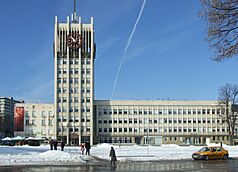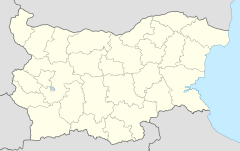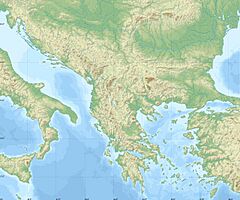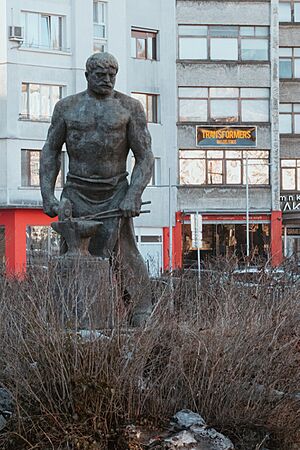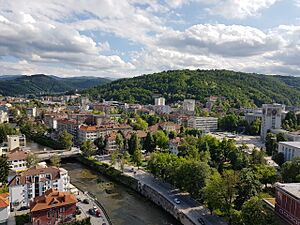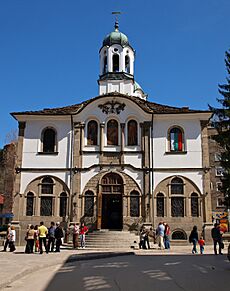Gabrovo facts for kids
Quick facts for kids
Gabrovo
Габрово
|
|||
|---|---|---|---|
|
city
|
|||
|
From the top, Town Hall, Orlovets Hall, House of Humour and Satire
|
|||
|
|||
| Country | Bulgaria | ||
| Province (Oblast) |
Gabrovo | ||
| Area | |||
| • city | 233.817 km2 (90.277 sq mi) | ||
| Elevation | 392 m (1,286 ft) | ||
| Population
(Census 2021)
|
|||
| • city | 48,133 | ||
| • Density | 205.8576/km2 (533.169/sq mi) | ||
| • Urban | 54,608 | ||
| Time zone | UTC+2 (EET) | ||
| • Summer (DST) | UTC+3 (EEST) | ||
| Postal Code |
5300
|
||
| Area code(s) | 066 | ||
| Website | Official website: http://www.gabrovo.bg/en | ||
Gabrovo (pronounced Gah-bro-vo) is a city in central northern Bulgaria. It's the main city of Gabrovo Province.
It sits at the foot of the central Balkan Mountains, in the valley of the Yantra River. Gabrovo is famous worldwide as a capital of humour and satire. It's also known for its beautiful old buildings from the Bulgarian National Revival period. Gabrovo is the longest town in Bulgaria, stretching over 25 kilometers along the Yantra River. Yet, it's only about 1 kilometer wide in some places. The geographic center of Bulgaria, Uzana, is located near the town.
Contents
What's in a Name? Gabrovo's Origin
The most popular story about Gabrovo's name comes from a blacksmith named Racho. A hornbeam tree grew near his fireplace. So, the settlement got its name from the Slavic word gabar, which means "hornbeam."
Gabrovo's Journey Through Time
The area around Gabrovo has been home to people since the Neolithic Age (New Stone Age). It became important for its economy after Veliko Tarnovo became the capital of the Second Bulgarian Empire in the 12th century. Skilled workers and traders did well here because it was close to the capital and the mountain passes. In the Middle Ages, Gabrovo was a small village with about 100 houses.
After the Ottoman invasion in the 14th century, many Bulgarians fled from the conquered capital. They found a safe and attractive place in Gabrovo. It grew from a village into a small town. It started to become an important center for business, culture, and spiritual life.

During Ottoman rule, wealthy traders invested a lot in the town's development. The first Bulgarian school that was not religious, the Aprilov National High School, was founded in Gabrovo in 1835. This was thanks to the help of Vasil Aprilov and Nikolay Palauzov. The Ottoman authorities officially declared Gabrovo a town in May 1860.
In the 1870s, a traveler named Felix Kanitz called Gabrovo "a big workshop." He also said it was a "city that lives from the water," because water power was used a lot. Gabrovo's goods became famous throughout the Ottoman Empire and even beyond. Today, there is still a street in Bucharest named "Gabroveni."
After Bulgaria became free in 1878, Gabrovo grew into a center for industry. This was built on its strong trading history. New companies were formed, factories were built, and connections to big stock exchanges were made. Because of this, some people called the town "The Bulgarian Manchester."
Gabrovo's People
Gabrovo grew very quickly after World War II. Its population doubled during this time. However, after the fall of Communism, the number of people living in Gabrovo started to decrease. Many people moved abroad or to the capital city of Sofia.
At its peak, between 1985 and 1991, Gabrovo had over 80,000 residents. Today, the population is smaller. According to the 2011 Census, the town had 58,950 inhabitants.
Who Lives in Gabrovo?
Most people in Gabrovo are Bulgarians. According to the 2011 census, here's how the different groups were represented:
- Bulgarians: 97.9%
- Turks: 0.9%
- Roma: 0.6%
- Others: 0.3%
Culture and Fun in Gabrovo
Gabrovo is known around the world as a center for humour and satire. It has two theaters: the Racho Stoyanov Drama Theatre and a puppet theater. There's also a special place called the House of Humour and Satire. This place is a cultural center, museum, and art gallery that promotes funny art.
The town also has a cinema, Aleko Cinema. You can visit many museums and memorial houses in and around Gabrovo. Two famous ones are the Etar Architectural-Ethnographic Complex and the National Museum of Education at the Aprilov National High School.
Every year, around May 21, Gabrovo hosts a fun Carnival of Humor and Satire. Its Bulgarian slogan means "Let's go nuts from laughter!" During the carnival, the streets are full of people dressed in funny costumes. You can see masked musketeers, bullfighters, shamans, and more. The carnival also features traditional Balkan songs, folk dances, and lots of Gabrovo humour.
There is also a planetarium in Gabrovo where you can learn about stars and space.
Places to Visit in Gabrovo
When you visit Gabrovo, you should see the House of Humour and Satire and the Aprilov National High School. In Gabrovo Province, you can explore the architectural reserve of Bozhentsi.
If you love hiking, you can explore the Central Balkan National Park and the Bulgarka Nature Park. Inside Bulgarka Nature Park, you'll find the Ethnographic Complex Etara, Dryanovo Monastery, Sokolski Monastery, and the Uzana area. For history fans, the Shipka Memorial is a must-see. Gabrovo is also part of the Creative Tourism Network®.
Sports in Gabrovo
- The town's most successful sports club is FC Yantra Gabrovo, which started in 1919.
- Gabrovo also has a long history with handball.
- About 25 kilometers from the town, in the Central Balkan Mountains, is the famous winter resort Uzana.
Gabrovo's Special Honors
A minor planet called 2206 Gabrova was discovered on April 1, 1976. It was named after the town of Gabrovo. This discovery was made by a Soviet astronomer named Nikolai Stepanovich Chernykh.
Also, Gabrovo Knoll on Livingston Island in Antarctica is named after Gabrovo.
Famous People from Gabrovo
Many notable people have come from Gabrovo:
- Vasil Aprilov (1789–1847) - A leader in the Bulgarian National Revival and founder of the first non-religious school in Bulgaria.
- Ivan Hadji Berov (1858–1934) - An industrialist who brought the first light bulb to Bulgaria and built the first hydroelectric power plant in Gabrovo.
- Tsanko Dyustabanov (1844–1876) - A revolutionary who fought for Bulgaria's freedom.
- Ivan Kolchev Kalpazanov (1835–1889) - An industrialist who helped start modern industry in Gabrovo and Bulgaria.
- Vasil Nikolov Karagiosov (1856–1938) - A teacher, industrialist, and politician.
- Nikolay Palauzov (1821–1899) - A merchant who gave money to help the Gabrovo school.
- Petar Rúsеv - The father of a former Brazilian president, Dilma Rousseff.
- Tota Venkova (1855 – 1921) - The first Bulgarian woman doctor. The regional hospital in Gabrovo is named after her.
- Christo Yavashev (1935–2020) - A world-famous artist known for his large-scale art installations.
Learning in Gabrovo
Technical University
Gabrovo is home to one of the biggest technical universities in Bulgaria, the Technical University of Gabrovo. This university opened in 1964, but the idea for it goes back to the 1840s. Today, about 5,400 students attend the university, including around 60 students from other countries.
Gabrovo's Sister Cities
Gabrovo has "sister city" relationships with many cities around the world. This means they share cultural and educational ties.
See also
 In Spanish: Gabrovo para niños
In Spanish: Gabrovo para niños


